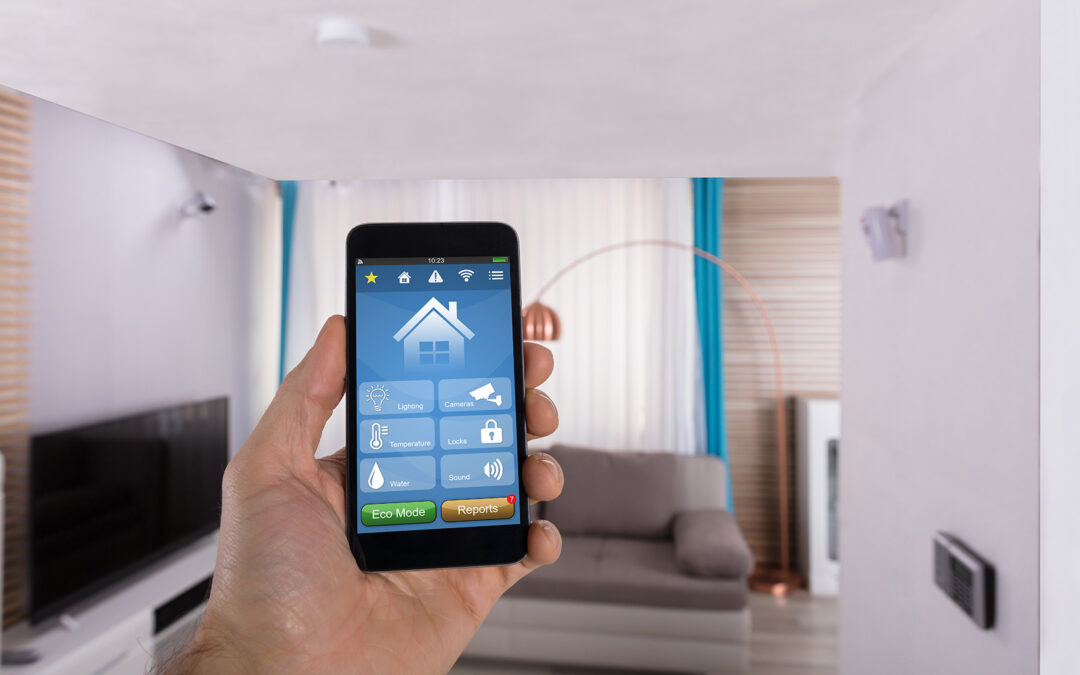Smart home devices are no longer futuristic gadgets reserved for early adopters. Across the United States, households are embracing connected technology to add convenience, security, energy savings, and even wellness to their daily lives. This article explores how Americans are using smart home devices in 2025, examines usage and perceptions data, delves into benefits and concerns, and provides actionable insights if you’re considering upgrading your home.
🇺🇸 The State of Smart Home Adoption in the U.S.
Adoption Snapshot
- Research from Parks Associates shows that in the U.S., roughly 45% of internet-connected households own at least one smart home device. Parks Associates
- A more recent report from Horowitz Research (2025) states that 48% of American homes have at least one smart home device, with younger and multicultural consumers driving higher adoption rates. Horowitz Research
- The U.S. smart home market is projected to grow from about USD 33.26 billion in 2025 to nearly USD 99.40 billion by 2032, at a CAGR of ~16.9%. Fortune Business Insights
Usage Patterns
- The average U.S. home with smart devices reportedly owns around 4.8 different types of devices. Horowitz Research
- Device types frequently cited include: home security cameras (66%), smart sound systems (57%), doorbells/door cams (52%), and smart lightbulbs/fixtures (35%). Horowitz Research
- Young adults (18-34) lead adoption — 59% of that age group own at least one smart home device, vs. 37% of those aged 50+. Horowitz Research
These numbers reflect a strong and growing willingness among American consumers to integrate connected home technologies into their everyday lives.
🧭 Why Americans Use Smart Home Devices – The Key Motivations
Here are the major reasons why U.S. households are embracing smart home technologies:
- Convenience & Automation
Smart devices let homeowners automate everyday tasks — adjusting thermostats from a phone, setting lighting scenes, or controlling appliances remotely. - Security & Peace of Mind
Many Americans invest in smart locks, doorbell cameras, and security sensors to monitor their homes while they’re away, respond to alerts, and feel safer. For example, security & safety devices have seen strong growth. Today’s Homeowner+1 - Energy Efficiency & Cost Savings
Smart thermostats, lighting controls, and HVAC zoning systems help reduce energy usage. According to “Today’s Homeowner,” remote control of a smart thermostat can save around 8 % on heating/cooling bills. Today’s Homeowner - Health & Wellness Monitoring
Some smart home setups are used for wellness – indoor air quality sensors, smart lighting that supports circadian rhythms, appliances that support healthier living. A study in JMIR highlighted how smart-home advancements support health care and wellness. JMIR - Resale & Home Value Improvements
According to one statistics summary, installing smart home features can increase a home’s resale value by around 5 %. Today’s Homeowner
📋 How Americans Are Using Smart Home Devices – Types & Trends
Here’s a table summarizing how various device types are being used in U.S. homes, and some of the major trends:
| Device Type | Typical Usage in U.S. Households | Trend Highlights |
|---|---|---|
| Smart Security Cameras / Doorbells | Monitoring visitors remotely, alerts when motion detected | High adoption (≈ 66 % among smart-device homes) Horowitz Research |
| Smart Thermostats / HVAC Control | Remote temperature control, scheduling, energy savings | Energy-focus increasing since pandemic Today’s Homeowner+1 |
| Smart Lighting & Fixtures | Remote on/off, mood scenes, color changes, automation | Growing as retrofit cost falls Today’s Homeowner |
| Voice Assistants & Smart Speakers | Hands-free control of home devices, music, queries | Earlier area of high adoption; now integrated in many homes |
| Smart Appliances (Fridge, Oven) | Inventory tracking, remote cook control, IoT features | High cost but increasing interest Today’s Homeowner |
| Wellness / Health Sensors | Air-quality monitors, sleep sensors, home-health tracking | Emerging strongly, referenced in academic reviews JMIR |
🔐 Security & Privacy: What U.S. Users Think
Even as smart home devices become more common, many Americans express concerns about cybersecurity, privacy, and device reliability.
- A survey by National Institute of Standards and Technology (NIST) in 2025 of 401 U.S. smart-home users found that perceptions of security and privacy vary significantly across device categories. Voice assistants were viewed as most problematic; security devices and thermostats engendered more user confidence. NIST
- Academic research likewise shows that while many users worry about data being collected and how it’s used, they often do not take strong preventive measures — the so-called “privacy paradox”. Today’s Homeowner
- A 2025 peer-reviewed article Responsible Smart Home Technology Adoption notes that ethical concerns, transparency in device behavior, and consumer education are increasingly critical for adoption. ScienceDirect
This underscores that while Americans are adopting smart home devices, many remain skeptical or cautious about their implications — which presents opportunities for device makers and service providers to build trust.
👥 Adoption Differences by Demographic & Household Type
Usage and adoption differ across demographic segments in the U.S.:
- Younger households (ages 18-34) lead adoption: 59% own at least one smart home device. Horowitz Research
- Multicultural households have higher adoption levels: Latinx households (59%) and Black households (53%) exceed the national average of ~48%. Horowitz Research
- Families with children tend to have more smart devices (average 5.4 types) compared to other households. Horowitz Research
- Older households (50+) under-index in smart home ownership (~37%). Horowitz Research
For potential buyers or marketers, this means tailoring messaging and offerings by age group, family status, and cultural context can improve relevance and adoption.
🛠️ How to Use Smart Home Devices Effectively – Actionable Tips
If you’re considering adding smart home technology or optimizing what you already have, here are practical steps Americans are finding helpful:
1. Start with a Clear Use-Case
Before buying, identify what you want: energy savings, security, convenience, or health monitoring. This helps avoid random gadget purchases.
2. Ensure Compatibility & Ecosystem Fit
Check that any new device works with your existing platform (Amazon Alexa, Google Home, Apple HomeKit). Interoperability is becoming more important with standards like Matter gaining traction. Wikipedia
3. Secure Your Network
Since many devices communicate over your home network, ensure your Wi-Fi is secured, passwords are strong, and firmware is up to date. The NIST study shows users often underestimate risks for some device categories. NIST
4. Automate Gradually
Start simple – e.g., a smart thermostat or a smart light with scheduling. Once you’re comfortable, you can layer in routines or combined workflows (e.g., “Away Mode” that locks doors, turns off lights, sets security cameras). Americans are seeing greater value when devices are integrated rather than stand-alone.
5. Monitor and Measure Value
Track whether your smart devices deliver value: Did the smart thermostat lower energy bills? Did cameras reduce worry or enhance security? As owners report, perceived benefit influences continued usage.
6. Stay Informed About Privacy & Data
Understand what data your device collects, how it is used, and what control you have. This is a growing concern among U.S. users and a barrier for some households. ScienceDirect+1
7. Plan for Maintenance
Devices need updates, battery changes, and sometimes recalibration. Recognise that smart ≠ maintenance-free. Consider whether you’re comfortable managing them.
✅ Benefits Reported by U.S. Homeowners
Here are some of the key benefits that Americans using smart home devices are experiencing:
- Improved convenience: Control devices with voice or app, automate routines.
- Greater security: Real-time alerts, remote monitoring, peace of mind.
- Energy efficiency: Smart climate control and lighting reduce wastage.
- Health and wellness opportunities: Some integrate sensors for air quality, sleep, or occupancy tracking.
- Home value enhancement: Smart features increasingly seen as desirable in real estate.
These benefits align with what market research highlights for U.S. households with smart devices. Today’s Homeowner+1
🚧 Challenges & Barriers in the U.S. Market
Even with strong adoption, there are clear obstacles Americans face:
- Cost-barrier: Upfront costs for smart devices and installation can deter some homeowners. Today’s Homeowner
- Complexity and technical anxiety: Some segments feel they lack the skills to install or manage.
- Connectivity & reliability issues: Reports indicate some U.S. households with smart homes experience connectivity problems. Fortune Business Insights
- Privacy and security concerns: A significant number of users worry about data usage, hacking, or surveillance risks.
- Fragmented ecosystem: With many brands and standards, compatibility can be confusing — a concern the Matter standard is trying to address. Wikipedia
📈 Smart Home Use Cases: Real-Life Examples in America
Case A: Smart Security for Families
Many U.S. families install smart doorbell cameras and indoor/outdoor security sensors. These enable remote monitoring, alerting to children coming home from school, or verifying visitors when not at home. The convenience and reassurance from real-time visuals and alerts are strong motivators.
Case B: Energy & Climate Control in Aging Homes
Homeowners in older homes often retrofit smart thermostats and smart lighting. They appreciate that devices can help monitor energy use, suggest scheduling changes, and integrate with existing HVAC systems to reduce monthly bills.
Case C: Wellness & Aging-in-Place
For seniors or households with older adults, sensor networks (motion sensors, fall detectors, smart cameras) combined with alert workflows allow independence with oversight. Academic research (see JMIR smart-home for health article) supports that smart home tech in health monitoring is viable. JMIR
Case D: Multi-Dwelling / Urban Settings
Apartment dwellers in urban America are adopting smart lighting, smart plugs, and voice assistant speakers to simplify daily living and compensate for less control over the building infrastructure. The adoption among multifamily and younger residents is higher. Horowitz Research
🧠 Scientific Insights on Smart Home Technology & Behavior
Researchers have recently explored how smart home devices affect behavior, trust, and adoption. A few key takeaways:
- A study published in JMIR reviewed 20 years of smart home literature and found that wellness and health-oriented smart home technologies (e.g., passive monitoring, ambient sensing) are increasingly integrated into daily life, and user acceptance depends significantly on trust, perceived usefulness, and ease of use. JMIR
- The “Responsible Smart Home Technology Adoption” article identified that ethical considerations, transparency of device behavior, and user education are central to increased uptake. ScienceDirect
- The NIST-surveyed data emphasises that users’ security perceptions vary by device type: for instance, voice assistants are seen as riskier than thermostats. This suggests manufacturers and service providers need device-specific trust strategies. NIST
These findings underscore that hardware alone isn’t sufficient; human factors, education, and trust matter if smart home technology is to deliver value at scale.
📅 What’s on the Horizon for U.S. Smart Homes in 2025 and Beyond
Here are emerging trends and what they indicate for American smart-home households:
- Greater interoperability: Standards like Matter aim to simplify compatibility between devices from different brands. Wikipedia
- Health and wellness integration: Smart homes will increasingly serve as platforms for wellness monitoring, especially for aging populations and multi-generational households.
- Professional services & managed smart home support: As the number of connected devices grows (average 17 per home in a 10-year view by Parks Associates) there’s growing demand for managed services and bundling through ISPs and utilities. Parks Associates
- Focus on privacy/security as selling points: As consumer concern grows, brands that emphasise robust security, data transparency, and minimal invasiveness will gain advantage.
- Smart home as part of home value enhancement: With real estate values being influenced by tech features, smart home features may move from optional to expected in many homes.
- Sustainability and energy management: Smart home devices will increasingly be used not just for convenience, but to monitor and reduce energy footprint — aligning with U.S. and global sustainability goals.
✅ How to Decide if Smart Home Devices Are Right for You
If you’re an American homeowner or renter considering jumping into smart home tech in 2025, ask yourself these questions:
- What problem am I trying to solve? (Security, energy, convenience, wellness?)
- Does my home infrastructure support it? (WiFi strength, device compatibility)
- Am I comfortable with the digital aspects — apps, devices, updates?
- Do I understand the privacy/security trade-offs?
- Can I adopt gradually and scale, rather than over-invest upfront?
- Do I want future-proofing (interoperability, standard support) or just point-solutions?
Smart home adoption should be guided, not impulsive. The data from U.S. research shows that households who start with one meaningful use case and expand from there tend to see higher satisfaction.
❓ Frequently Asked Questions (FAQs)
Q1: What percentage of American homes have smart home devices in 2025?
A: According to recent data, about 48% of U.S. homes have at least one smart home device. Horowitz Research
Q2: Which U.S. demographic groups use smart home devices the most?
A: Younger adults (18-34) and multicultural households lead in adoption. For example, 59% of 18-34 year-olds and 59% of Latinx households report owning at least one smart device. Horowitz Research
Q3: Are smart home devices secure? Should I be worried about privacy?
A: While many devices offer strong security, research shows that perceptions vary by device type. Users feel more confident about thermostats/security devices and less confident about voice assistants. NIST+1 It’s wise to use strong passwords, change default settings, and keep firmware updated.
Q4: Do smart home devices save money?
A: Yes, many users report savings. For example, a smart thermostat can reduce heating & cooling bills by about 8% according to one source. Today’s Homeowner But actual savings depend on usage, home insulation, and local energy rates.
Q5: What should I buy first if I’m new to smart home tech?
A: Start with one meaningful device that addresses a key need (e.g., smart thermostat for energy savings or a smart security camera for peace of mind). Ensure it’s compatible with your ecosystem and you understand how to manage it.
Q6: Will smart home devices increase my home value?
A: Yes, some studies suggest smart home features can raise resale value by around 5%. Today’s Homeowner
Q7: What are the emerging trends in U.S. smart home adoption for 2025?
A: Expect greater device interoperability (Matter standard), more health/wellness integration, more emphasis on privacy and security, and more managed services from ISPs and utilities.



